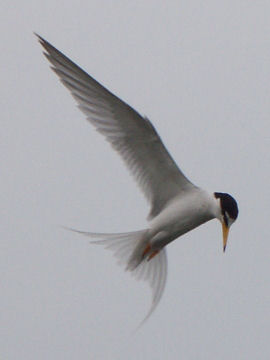|
| Query: south american tern | Result: 4th of 5 | |
Little Tern (Sternula albifrons) - Wiki
| Subject: | Little Tern (Sternula albifrons) - Wiki
| |

| Resolution: 270x360
File Size: 49486 Bytes
Date: 2005:06:01 15:37:23
Camera: DiMAGE A1 (Minolta Co., Ltd.)
F number: f/3.5
Exposure: 1/640 sec
Focal Length: 13004/256
Upload Date: 2006:12:22 01:22:02
|
Little Tern
From Wikipedia, the free encyclopedia
[Photo] "Koajisashi" (Sterna albifrons, in summer) left from sea and went to a city park for breeding. Date: Jun 01, 2005. Place: Todoroki ryokuchi (city park) Kawasaki Kanagawa, Japan. Author: ISAKA Yoji (cory). Comment: "He was flying and stopping over a lake in city park to get fish for his children."
The Little Tern (Sternula albifrons) is a seabird of the tern family Sternidae. It was formerly placed into the genus Sterna, which now is restricted to the large white terns (Bridge et al., 2005). The former North American (S. a. antillarum) and Red Sea S. a. saundersi subspecies are now considered to be separate species, the Least Tern (Sternula antillarum) and Saunders's Tern (Sternula saundersi).
This bird breeds on the coasts and inland waterways of temperate and tropical Europe and Asia. It is strongly migratory, wintering in the subtropical and tropical oceans as far south as South Africa and Australia.
The Little Tern breeds in colonies on gravel or shingle coasts and islands. It lays two to four eggs on the ground. Like all white terns, it is defensive of its nest and young and will attack intruders.
Like most other white terns, the Little Tern feeds by plunge-diving for fish, usually from saline environments. The offering of fish by the male to the female is part of the courtship display.
This is a small tern, 21-25 cm long with a 41-47 cm wingspan. It is not likely to be confused with other species because of its size and white forehead in breeding plumage. Its thin sharp bill is yellow with a black tip and its legs are also yellow. In winter, the forehead is more extensively white, the bill is black and the legs duller. The call is a loud and distinctive creaking noise.
Little Tern on European rivers
At the beginning of the 19th century the Little Tern was a common bird of European shores, rivers and wetlands, but in the 20th century populations of coastal areas decreased cause of habitat loss, pollution and human disturbance.
The loss of inland populations has been even more severe, since due to dams, river regulation and sediment extraction it has lost most of its former habitats. The Little Tern population has declined or become extinct in many European countries, and former breeding places on large rivers like the Danube, Elbe and Rhine ceased. Nowadays, only few river systems in Europe possess suitable habitats; the Loire/Allier in France, the Vistula/Odra in Poland, the Po/Ticino in Italy, the Daugava in Latvia, the Nemunas in Lithuania, the Sava in Croatia and the Drava in Hungary and Croatia. The status of the Little Tern on the rivers Tagus and lower Danube is uncertain.
The Drava population is one of the most threatened. Old fashioned water management practices, including river regulation and sediment extraction, endanger the remaining pairs. Only 15 pairs still breed on extensive sand or gravel banks along the border between Hungary and Croatia. The WWF and its partners are involved in working for the protection of this bird and this unique European river ecosystem. The Little Tern is one of the species to which the Agreement on the Conservation of African-Eurasian Migratory Waterbirds (AEWA) applies.
http://en.wikipedia.org/wiki/Little_Tern
| The text in this page is based on the copyrighted Wikipedia article shown in above URL. It is used under the GNU Free Documentation License. You may redistribute it, verbatim or modified, providing that you comply with the terms of the GFDL. |
|
^o^
Animal Pictures Archive for smart phones
^o^
|
|

